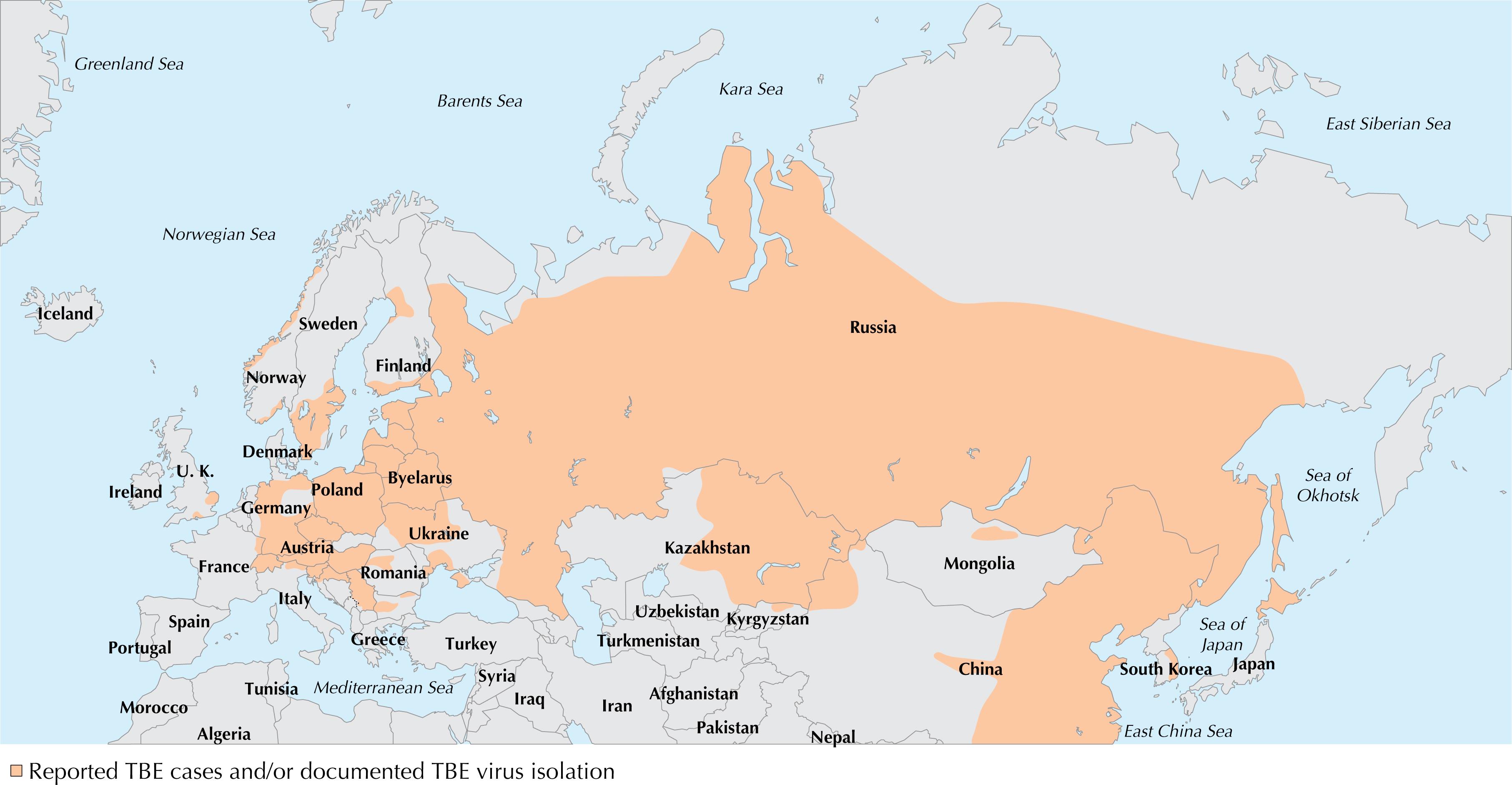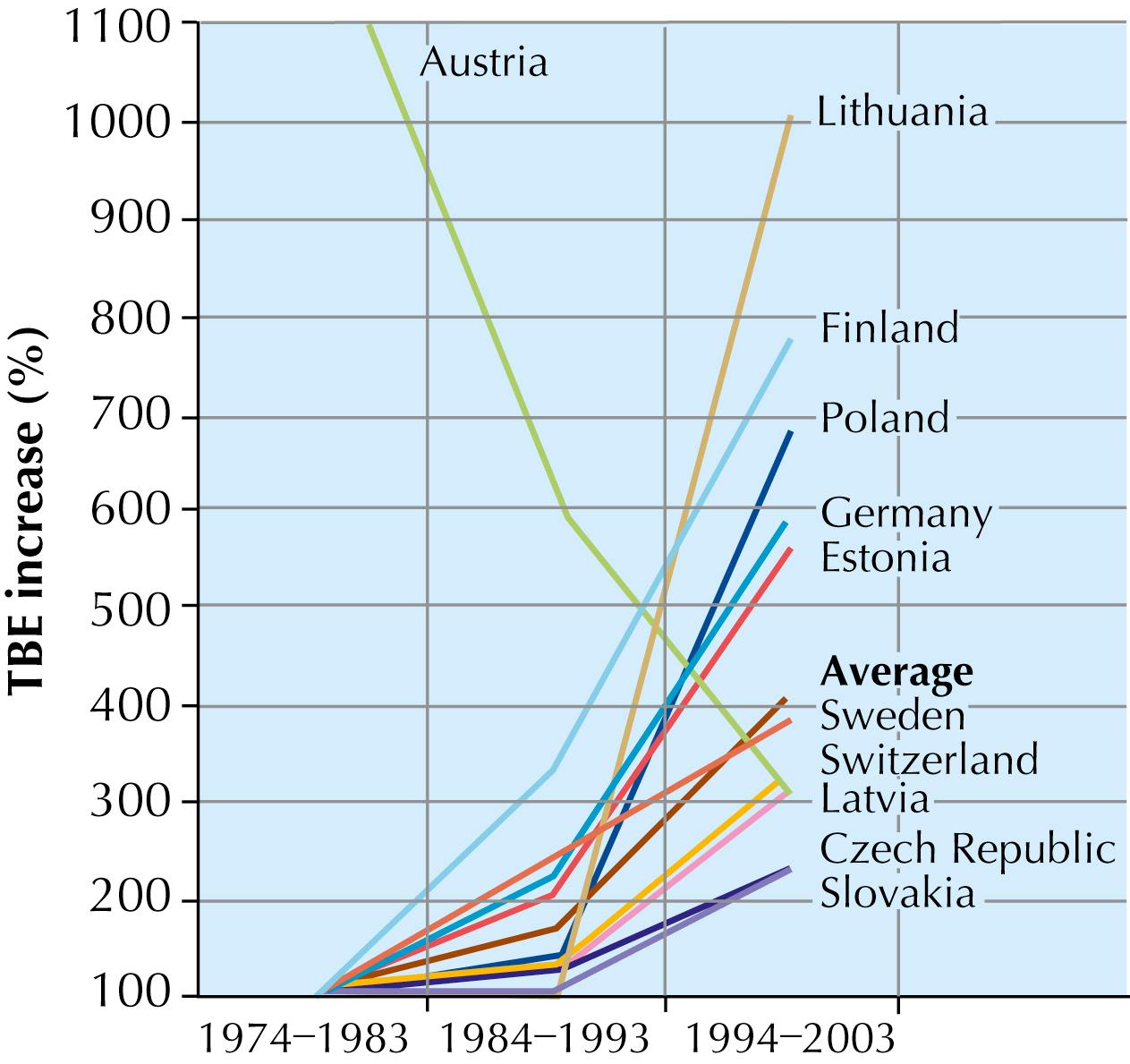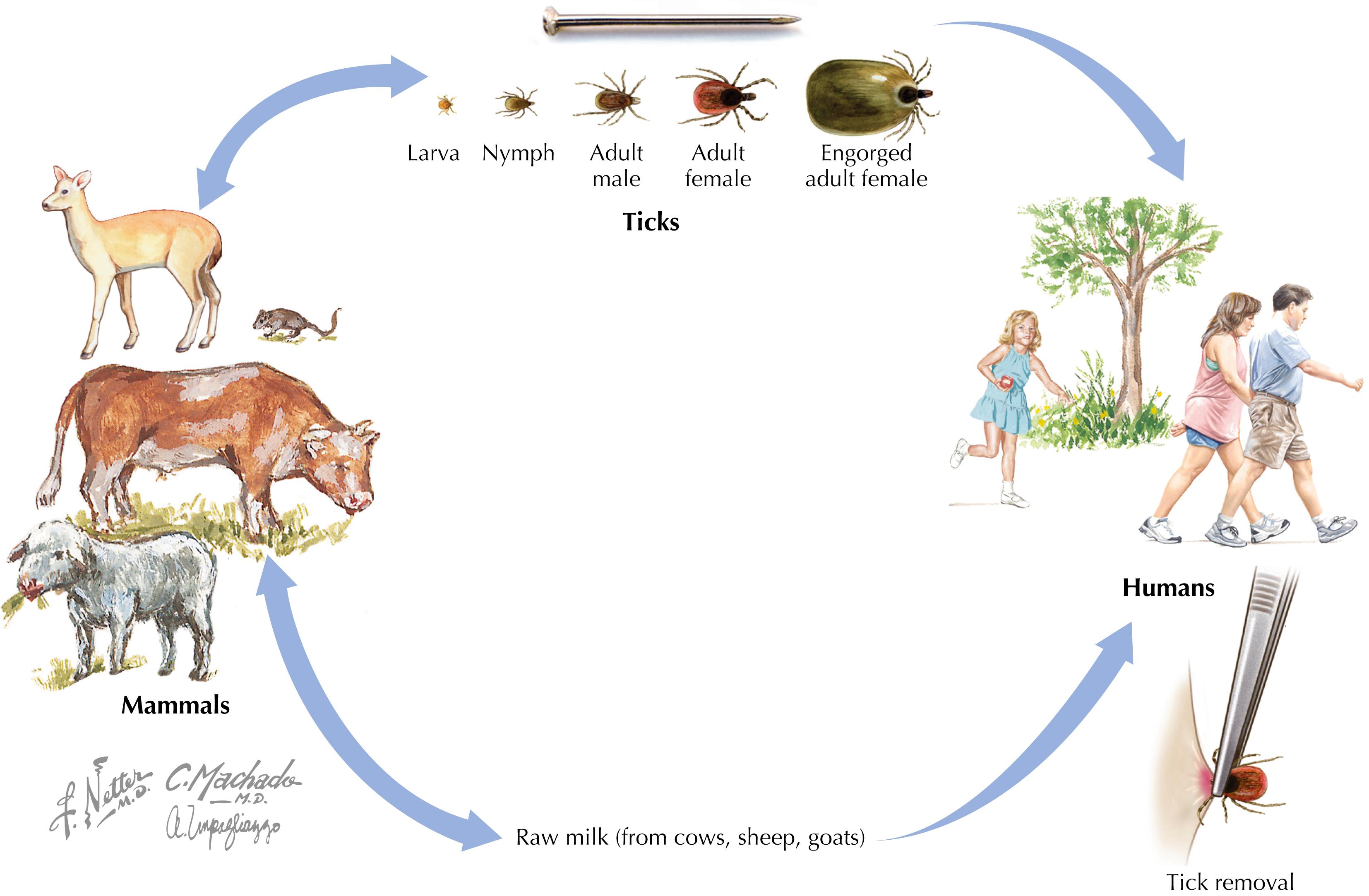Physical Address
304 North Cardinal St.
Dorchester Center, MA 02124
I want to thank the companies of Baxter, Novartis, Pfizer, and GSK for providing information including data and graphics. In particular, Dr. Dieter Gniel was very helpful in sharing his vast experience on TBE.
For a long time, tick-borne encephalitis (TBE) was perceived as a risk only (if ever) for the local populations living in endemic areas. There was very little specific awareness and hardly any knowledge about this viral disease among doctors (not to mention lay people, including travelers) outside the endemic areas. Thus, despite high incidence rates in the local populations of some endemic areas, TBE has been and mostly still is a neglected travel-associated health risk.
World Tourism Organization statistics show that the European continent continues to be the main travel destination of international travelers. Considerable parts of this continent, especially those with the highest recent increases in international tourism (i.e., the Baltic States) as well as parts of Asia have proven to be TBE-endemic areas ( Fig. 72.1 ). As shown in Fig. 72.2 , there has been a substantial increase in nearly all European TBE-endemic countries (with the exception of Austria, where vaccination was introduced in 1981, and a general recommendation to vaccinate against TBE was implemented soon after). Thus it is increasingly important to provide the local population as well as travelers to these areas with current information on the risk of disease transmission and the possibilities of prophylaxis in general and vaccination in particular.


TBE is known by a variety of names, including spring-summer encephalitis, Central European encephalitis, Far-East Russian encephalitis, Taiga encephalitis, Russian spring-summer encephalitis, bi-undulating meningoencephalitis, diphasic milk fever, Kumlinge disease, Schneider disease, and, in German-speaking areas, Früh-Sommer-Meningo encephalitis (FSME) or early-summer meningoencephalitis—a description that might be misleading, as shown later.
In its most severe form, the infection affects the central nervous system (CNS), mostly as a meningoencephalitis leading to persistent sequelae in up to 58% of patients. Prophylaxis is focused on the avoidance of exposure and on vaccination. Because many of the TBE-endemic areas are increasingly popular tourist destinations, it seems of utmost importance to raise awareness among local people as well as travelers and their health advisors, primary care medicine practitioners, infectious disease specialists, and travel medicine and vaccination centers.
A 32-year-old businessman went river rafting in the southern part of Austria. Two weeks later he developed a fever and subsequently neurologic symptoms, starting with headache and nausea followed by typical signs of meningitis and encephalitis: stiff neck, vomiting, and photophobia. He was the only member of his family (including his wife and 5-year-old son) who was not vaccinated against TBE, and he could not recall a tick bite. Based on the deterioration of his clinical status, he was brought to the emergency room of a nearby tertiary referral hospital.
Because this happened in a TBE-endemic area and the patient’s history indicated a substantial likelihood of exposure, this disease was high on a short list of differential diagnoses. Thus, in addition to the usual examination of patients with symptoms of meningoencephalitis (including differential white blood cell count, lactate dehydrogenase [LDH], lumbar puncture, and examination of the cerebrospinal fluid [CSF]), a serologic test for TBE was performed (enzyme-linked immunosorbent assay [ELISA] only). All tests supported the likelihood of a viral infection involving the brain, and the ELISA test revealed positive IgM antibodies against TBE (IgG negative). A computed tomography (CT) scan of the head showed disseminated foci of inflammation and tissue destruction, which led to the most likely diagnosis of severe TBE (confirmed by a subsequent serologic test showing the classic immunoglobulin switch with TBE-IgG becoming highly positive and the TBE-IgM becoming negative). Although the patient was treated in the intensive care unit with maximal supportive care, the infection progressed and, after some days, led to the need for artificial ventilation. Subsequent CT scans showed further deterioration, which ultimately resulted in an apallic syndrome. After approximately 3 years of intensive care (owing to the need for artificial ventilation, the patient could not be discharged from the hospital), permission to withdraw all life support was obtained.
COMMENT: Although only a certain proportion of tick bites in TBE-endemic areas bears the risk of transmission and only a small percentage of infections result in classical disease, TBE can permanently impair previously healthy persons and poses the risk of death as a worst-case scenario. In contrast to other diseases, such as Lyme borreliosis, TBEV infection starts immediately after the attached tick starts its blood meal; therefore even timely removal of the tick may not suffice to prevent infection. Because there is no option of postexposure prophylaxis (administration of hyperimmune globulin was stopped due to the risk of viral enhancement and is no longer available in Western countries) and no causal treatment for this potentially devastating disease, strict adherence to safe behavior patterns as well as vaccination (for persons living in or going to or through high-risk areas) should be strongly recommended.
The TBE virus (TBEV) is a single-stranded ribonucleic acid (RNA) virus belonging to the Flaviviridae family; it therefore shows some similarities with other viruses in this family (e.g., dengue virus [DENV], Powassan virus [POWV], West Nile virus [WNV], Japanese encephalitis virus [JEV], yellow fever virus [YFV], and Zika virus [ZV]). The TBEV is fairly homogeneous in endemic areas of Europe (European subtype). There are two additional subtypes within the same group with few genetic differences: the recently identified Siberian subtype (which genetically is quite closely linked to the European subtype) and the Far Eastern subtype.
TBE is transmitted by hard ticks and by the consumption of infected raw milk. In addition, there is an occupational health risk in laboratories for those working with material contaminated by or infected with TBEV. By far the most frequent mode of transmission to humans is by bites of certain species of hard ticks (i.e., Ixodes ricinus and Ixodes persulcatus ) that have previously fed on infected reservoir hosts ( Fig. 72.3 ). With some areas of overlap, I. ricinus (the common castor-bean tick) mostly inhabits the western part, and I. persulcatus (Taiga tick) is mainly found in the eastern part of the endemic area that roughly stretches from the Alsace region of France and eastern parts of the Netherlands (first identified in 2016) in the west to Hokkaido Island, Japan, in the east, and in Europe from Scandinavia in the north to Italy, Albania, and Greece in the south and from Russia in the north to southern China and South Korea in the south in Asia respectively. In 2019, the first autochthonous case was published in the United Kingdom.

According to old published data, TBEV prevalence in the tick population in endemic areas may be as low as 0.05% in Italy and 0.07% in Finland and as high as 26.6% in some regions of Latvia. Although replication in Dermacentor marginatus was already proven experimentally in 1985, TBEV infection linked with high probability to a bite by this different hard tick species was published only in 2017.
One phenomenon contributing to an increasing prevalence of TBEV-infected tick populations is the fact that a vertical or transovarian transmission (i.e., a TBEV-infected female tick infects her eggs before oviposition) takes place as well as from an infected animal to a tick during a bite (or even from tick to tick by cofeeding on the same blood pool). In contrast to other blood-feeding arthropod vectors, ticks do not directly puncture blood vessels but feed from a “feeding pool” produced by vasoactive mediators and coagulation inhibitors released via the tick’s saliva. The blood meal of an adult female and immature blood-sucking nymphs may last up to 5 days, resulting in an approximately 120-fold increase of the volume of an adult female tick. Male ticks do not feed on blood at all but may repeatedly feed on a small amount of tissue fluid during a relatively short feeding period, which nevertheless may be sufficient for the transmission of the TBEV.
In addition to tick bites, another mode of transmission is by the consumption of infected raw milk and products made from it. This mode of transmission used to occur quite frequently in the Baltic States (e.g., Lithuania) and in Slovakia. Between 2012 and 2016, there were at least 13 outbreaks with 141 cases linked to the consumption of unpasteurized dairy products made from sheep and goat milk. In 2008, some cases of alimentary infection were reported for the first time in Austria; since 2016, a few episodes were also reported from Germany.
Another risk of exposure involves laboratory workers who deal with this virus.
In the past, at least in central Europe, most cases were seen in early summer. Later on, two peaks of this disease were described, with the recognition of an additional peak in late summer. Tick-biting activity appears to be increased by higher humidity and temperature. Also, owing to recent climate change observed in the whole region, currently at least eight new phenomena have been observed:
In addition to the steady growth of the geographic risk area at the same latitude accompanied by a confluence of scattered foci to larger endemic regions, the TBE endemic area boundary has moved northward, with the eruption of highly active foci in Scandinavia, for instance. In addition, the areas of risk include higher altitudes.
In some areas the two peaks of reported clinical cases have merged into one broader peak occurring in July and August.
In some areas, most likely as a result of warmer temperatures, the typical seasonal pattern with transmission-free intervals has vanished. Transmission seasons have expanded and, in some regions, year-round transmission is occurring.
The tick populations in some areas have substantially increased, probably because of climate change, which has led to more rain, warmer winters, and moister springs. As a consequence, the tick-bite season starts earlier and the different stages develop more quickly. Ixodes tick activity starts with a soil temperature of about 7°C and a relative humidity of at least 92% necessary for these ticks’ survival is provided by more frequent episodes of rainfall.
Dermacentor ticks (e.g., Dermacentor marginatus ) may transmit TBEV as well. The activity pattern of this tick species is different (e.g., the biting season lasts longer), which may also affect traditional seasonal transmission.
In most TBE-endemic countries, people have achieved higher standards of living. They have more leisure time, which, at least during the warm season, contributes to more exposure-prone outdoor activities. Furthermore, many families have shifted from living in apartments to having their own homes and gardens, bushes, and trees, all of which are associated with an increased risk of tick bites.
“Green thinking” results in some vaccination skepticism as well as addiction to “natural and healthy food,” which may include unpasteurized dairy products.
The emergence of the COVID-19 pandemic (SARS-CoV2) and the public health measures implemented to control transmission such as quarantine and travel restrictions had an unforeseen impact on the incidence of TBE subsequently experienced in some TBE-endemic countries. Weeks to months of quarantine at home mandates generated an increased demand among people for outdoor activities whenever possible. In addition, travel restrictions resulted in more people spending their holidays in their home country, which meant that nonimmune persons living in or going to TBE endemic areas like central Europe had increased exposure during their leisure time outdoor activities. This may have been one of the drivers for skyrocketing clinical TBE cases reported in Germany, Austria, and Switzerland in 2020. This should be considered in other epi-/pandemics to come, too.
These factors contribute to a higher risk of exposure to the TBEV. In most regions, this risk has shifted from being mainly occupational (forestry workers, farmers) to one affecting people anyone who spends leisure time outdoors (e.g., collecting mushrooms, playing golf, camping and picnicking, Nordic walking, hiking, trekking). This is particularly true for older people and those who are retired, who, if they acquire a TBE infection, tend to develop more severe symptoms.
As is the case with other infections, epidemiologic data reported officially depend on a variety of factors including awareness within the healthcare system; the availability of adequate diagnostic tools; the notification systems of regional, national, and international health authorities; and adherence among those who should report. The low awareness of TBE in nonendemic countries is likely to result in the underdiagnosis of clinical cases as well as in underreporting; these are the most probable explanations for the difference between the estimated attack rates among tourists and the numbers reported.
On a person-based calculation, the highest incidence published (98 per 100,000) was that among forestry workers in Austria in the prevaccination era; even today, however, case counts exceed 100 per 100,000 in high-risk areas (e.g., in the Baltic states) during high transmission seasons. As with other infectious diseases, not every infection results in specific clinical symptoms. The risk of symptomatic disease after a single tick bite in an endemic area varies from 1:200 to 1:1000. Actual epidemiologic data underline the importance of booster vaccinations of the local population as well as the vaccination of travelers going to endemic areas, as the risk of acquiring TBE in an endemic area is about the same as that for typhoid fever in nonvaccinated travelers going to India.
Become a Clinical Tree membership for Full access and enjoy Unlimited articles
If you are a member. Log in here